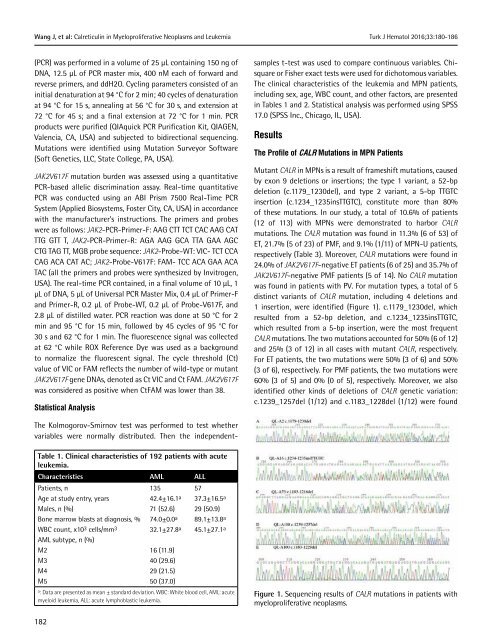Turkish Journal of Hematology Volume: 33 - Issue: 3
You also want an ePaper? Increase the reach of your titles
YUMPU automatically turns print PDFs into web optimized ePapers that Google loves.
Wang J, et al: Calreticulin in Myeloproliferative Neoplasms and Leukemia Turk J Hematol 2016;<strong>33</strong>:180-186<br />
(PCR) was performed in a volume <strong>of</strong> 25 µL containing 150 ng <strong>of</strong><br />
DNA, 12.5 µL <strong>of</strong> PCR master mix, 400 nM each <strong>of</strong> forward and<br />
reverse primers, and ddH2O. Cycling parameters consisted <strong>of</strong> an<br />
initial denaturation at 94 °C for 2 min; 40 cycles <strong>of</strong> denaturation<br />
at 94 °C for 15 s, annealing at 56 °C for 30 s, and extension at<br />
72 °C for 45 s; and a final extension at 72 °C for 1 min. PCR<br />
products were purified (QIAquick PCR Purification Kit, QIAGEN,<br />
Valencia, CA, USA) and subjected to bidirectional sequencing.<br />
Mutations were identified using Mutation Surveyor S<strong>of</strong>tware<br />
(S<strong>of</strong>t Genetics, LLC, State College, PA, USA).<br />
JAK2V617F mutation burden was assessed using a quantitative<br />
PCR-based allelic discrimination assay. Real-time quantitative<br />
PCR was conducted using an ABI Prism 7500 Real-Time PCR<br />
System (Applied Biosystems, Foster City, CA, USA) in accordance<br />
with the manufacturer’s instructions. The primers and probes<br />
were as follows: JAK2-PCR-Primer-F: AAG CTT TCT CAC AAG CAT<br />
TTG GTT T, JAK2-PCR-Primer-R: AGA AAG GCA TTA GAA AGC<br />
CTG TAG TT, MGB probe sequence: JAK2-Probe-WT: VIC- TCT CCA<br />
CAG ACA CAT AC; JAK2-Probe-V617F: FAM- TCC ACA GAA ACA<br />
TAC (all the primers and probes were synthesized by Invitrogen,<br />
USA). The real-time PCR contained, in a final volume <strong>of</strong> 10 µL, 1<br />
µL <strong>of</strong> DNA, 5 µL <strong>of</strong> Universal PCR Master Mix, 0.4 µL <strong>of</strong> Primer-F<br />
and Primer-R, 0.2 µL <strong>of</strong> Probe-WT, 0.2 µL <strong>of</strong> Probe-V617F, and<br />
2.8 µL <strong>of</strong> distilled water. PCR reaction was done at 50 °C for 2<br />
min and 95 °C for 15 min, followed by 45 cycles <strong>of</strong> 95 °C for<br />
30 s and 62 °C for 1 min. The fluorescence signal was collected<br />
at 62 °C while ROX Reference Dye was used as a background<br />
to normalize the fluorescent signal. The cycle threshold (Ct)<br />
value <strong>of</strong> VIC or FAM reflects the number <strong>of</strong> wild-type or mutant<br />
JAK2V617F gene DNAs, denoted as Ct VIC and Ct FAM. JAK2V617F<br />
was considered as positive when CtFAM was lower than 38.<br />
Statistical Analysis<br />
The Kolmogorov-Smirnov test was performed to test whether<br />
variables were normally distributed. Then the independentsamples<br />
t-test was used to compare continuous variables. Chisquare<br />
or Fisher exact tests were used for dichotomous variables.<br />
The clinical characteristics <strong>of</strong> the leukemia and MPN patients,<br />
including sex, age, WBC count, and other factors, are presented<br />
in Tables 1 and 2. Statistical analysis was performed using SPSS<br />
17.0 (SPSS Inc., Chicago, IL, USA).<br />
Results<br />
The Pr<strong>of</strong>ile <strong>of</strong> CALR Mutations in MPN Patients<br />
Mutant CALR in MPNs is a result <strong>of</strong> frameshift mutations, caused<br />
by exon 9 deletions or insertions; the type 1 variant, a 52-bp<br />
deletion (c.1179_1230del), and type 2 variant, a 5-bp TTGTC<br />
insertion (c.1234_1235insTTGTC), constitute more than 80%<br />
<strong>of</strong> these mutations. In our study, a total <strong>of</strong> 10.6% <strong>of</strong> patients<br />
(12 <strong>of</strong> 113) with MPNs were demonstrated to harbor CALR<br />
mutations. The CALR mutation was found in 11.3% (6 <strong>of</strong> 53) <strong>of</strong><br />
ET, 21.7% (5 <strong>of</strong> 23) <strong>of</strong> PMF, and 9.1% (1/11) <strong>of</strong> MPN-U patients,<br />
respectively (Table 3). Moreover, CALR mutations were found in<br />
24.0% <strong>of</strong> JAK2V617F-negative ET patients (6 <strong>of</strong> 25) and 35.7% <strong>of</strong><br />
JAK2V617F-negative PMF patients (5 <strong>of</strong> 14). No CALR mutation<br />
was found in patients with PV. For mutation types, a total <strong>of</strong> 5<br />
distinct variants <strong>of</strong> CALR mutation, including 4 deletions and<br />
1 insertion, were identified (Figure 1). c.1179_1230del, which<br />
resulted from a 52-bp deletion, and c.1234_1235insTTGTC,<br />
which resulted from a 5-bp insertion, were the most frequent<br />
CALR mutations. The two mutations accounted for 50% (6 <strong>of</strong> 12)<br />
and 25% (3 <strong>of</strong> 12) in all cases with mutant CALR, respectively.<br />
For ET patients, the two mutations were 50% (3 <strong>of</strong> 6) and 50%<br />
(3 <strong>of</strong> 6), respectively. For PMF patients, the two mutations were<br />
60% (3 <strong>of</strong> 5) and 0% (0 <strong>of</strong> 5), respectively. Moreover, we also<br />
identified other kinds <strong>of</strong> deletions <strong>of</strong> CALR genetic variation:<br />
c.1239_1257del (1/12) and c.1183_1228del (1/12) were found<br />
Table 1. Clinical characteristics <strong>of</strong> 192 patients with acute<br />
leukemia.<br />
Characteristics AML ALL<br />
Patients, n<br />
Age at study entry, years<br />
Males, n (%)<br />
Bone marrow blasts at diagnosis, %<br />
WBC count, x10 3 cells/mm 3<br />
AML subtype, n (%)<br />
M2<br />
M3<br />
M4<br />
M5<br />
135<br />
42.4±16.1 a<br />
71 (52.6)<br />
74.0±0.0 a<br />
32.1±27.8 a<br />
16 (11.9)<br />
40 (29.6)<br />
29 (21.5)<br />
50 (37.0)<br />
57<br />
37.3±16.5 a<br />
29 (50.9)<br />
89.1±13.8 a<br />
45.1±27.1 a<br />
a : Data are presented as mean ± standard deviation. WBC: White blood cell, AML: acute<br />
myeloid leukemia, ALL: acute lymphoblastic leukemia.<br />
Figure 1. Sequencing results <strong>of</strong> CALR mutations in patients with<br />
myeloproliferative neoplasms.<br />
182

















